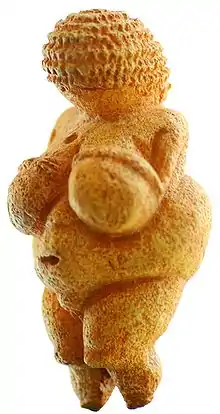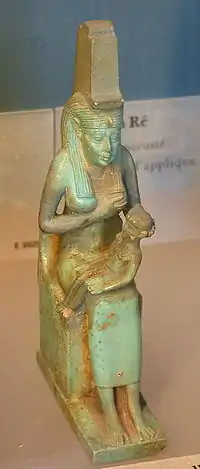الإلهة الأم
الإلهة الأم (Mother goddess) يُستخدم هذا المصطلح للإشارة إلى الإلهة التي تمثل الأمومة أوالخصوبة أوالإبداع، أو قد يشير إلى الإلهة التي تجسد فضل الأرض.[1][2][3] عندما تكون تلك الآلهة على قدم المساواة مع الأرض أو الطبيعة، يُشار إليهن أحيانًا باسم أم الأرض أو الأرض الأم.

يوجد اختلاف في الرأي بين المفهوم الأكاديمي والشعبي للمصطلح. يُدفع الرأي الشعبي أساسًا بحركة الإلهة، ويقول إن المجتمعات البدائية كانت في البداية أمومية، تعبد إلهة الأرض الأمومية الراعية ذات السيادة. استند هذا الرأي إلى أفكار القرن التاسع عشر عن التطور الأحادي ليوهان ياكوب باخوفن. وفقًا للرأي الأكاديمي، فإن كلًا من نظريات باخوفن ونظريات الإلهة الحديثة تشكل إسقاطًا لوجهات النظر العالمية المعاصرة حول الأساطير القديمة، بدلًا من محاولة فهم عقلية ذلك الوقت. غالبًا ما يكون هذا مصحوبًا برغبة في وجود حضارة ضائعة من حقبة ماضية كان يمكن أن تكون عادلة وسلمية وحكيمة. ولكن، يستبعد تمامًا وجود هذه الحضارة في أي وقت مضى.[4]
دافع المؤلفون النسويون لفترة طويلة، عن فكرة إبادة هذه المجتمعات الزراعية المسالمة والأمومية الزراعية أو إخضاعها من قبل قبائل بدوية محاربة أبوية. تُعتبر مساهمة عالمة الآثار ماريا جيمبوتاس من المساهمات الهامة في هذا الصدد. وقد شُكك في عملها في هذا المجال.[5] تثير هذه الرؤية حاليًا جدلًا كبيرًا بين علماء الآثار النسويين.[6][7]
منذ ستينيات القرن العشرين، وخاصةً في الثقافة الشعبية، رُبطت العبادة المزعومة للإلهة الأم والموقف الاجتماعي الذي يفترض تولي النساء السلطة في مجتمعات ما قبل التاريخ. جعل ذلك النقاش نقاشًا سياسيًا. ووفقًا لحركة الإلهة، ينبغي أن يعود المجتمع الحالي الذي يسيطر عليه الذكور إلى النظام الأموي المتساوي السائد في الأزمنة السابقة. يُفترض أن هذا الشكل من المجتمعات الموجود مسبقًا يُدعم بالعديد من التماثيل التي عُثر عليها.[8]
يُستبعد هذا النظام الأمومي في عصر ما قبل التاريخ في الأوساط الأكاديمية. أولًا، لأن عبادة إلهة الأم لا يعني بالضرورة أن المرأة حكمت المجتمع. وبالإضافة إلى ذلك، يمكن للتماثيل تصوير النساء أو الإلهات العاديات أيضًا، وليس واضحًا ما إذا كانت هناك إلهة أم.[9][10][11]
جاتال هويوك

قاد جيمس ميلار بين عامي 1961 و1965 سلسلة من الحفريات في جاتال هويوك، شمال جبال طوروس في منطقة زراعية خصبة تقع جنوب الأناضول. كان التماثيل العديدة التي وجدت هناك مذهلة، واقترح ميلار أنها تمثل إلهة عظيمة، كانت ترأس مجمع آلهة الحضارة الأمومية أساسًا.[12]
عُثر على تمثال أنثوي جالس، محاط باللبوات، حسب وصف ميلار، في صومعة حبوب؛ وربما كان القصد منها حماية المحصول والحبوب. واعتبر ميلار هذه المواقع أضرحة، وخاصةً امرأة جاتال هويوك الجالسة التي تثير الخيال. ووجد أيضًا عددًا كبيرًا من التماثيل ليس لها جنس محدد، اعتبرها ميلار نموذجية لمجتمع تهيمن عليه المرأة: فالتركيز على الجنس في الفن يرتبط دائمًا بدافع الذكور ورغبتهم.[13] دعمت عالمة الآثار ماريا جيمبوتاس فكرة إمكانية وجود نظام أمومي وعبادة للإلهة الأم هناك. أدى هذا إلى عبادة حديثة للإلهة الأم مع تنظيم الحج السنوي في جاتال هويوك.
منذ عام 1993، استؤنفت عمليات التنقيب التي يرأسها حاليًا إيان هودر مع لين ماسكل كرئيس لمشروع ستانفورد للتماثيل الذي فحص تماثيل جاتال هويوك. توصل هذا الفريق إلى استنتاجات مختلفة عن استنتاجات جيمبوتاس وميلار. ولم يُحدد سوى عدد قليل من التماثيل على أنها أنثوية ولم توجد كثيرًا في الأماكن المقدسة، ولكن بدا أنه جرى التخلص منها بشكل عشوائي، وفي أكوام القمامة أحيانًا. ما جعل عبادة الإلهة الأم في هذا الموقع مستبعدة.[14]
انظر أيضًا
- أنانكي (Ananke)
- أفروديت (Aphrodite)
- بريجيد (Brigid)
- كوبيلي (Cybele)
- ديڤي (Devi)
- دورجا (Durga)
- فريا (Freyja)
- هيكاتي (Hecate)
- عشتار (Ishtar)
- كالي (Kali)
- كاماكايا (Kamakhya)
- لاكشمي (Laxmi)
- موط (Mut)
- نارثيوز (Nerthus)
- أوبس (Ops)
- بوتنيا ثيرون (أي عشيقة للحيوانات) (Potnia Theron)
- ردها (Radha)
- ريا (Rhea)
- شاكتي (Shakti)
- إيبة (Tawaret)
- ياشودا (Yashoda)
- تلة على شكل ثدي
- شاتالاهوك (بالتركية:Çatalhöyük)
- دودونا (Dodona)
- الله الأب (Father God)
- إله (إله ذكر)
- نوع الإله
- إلهة
- حركة لإعلاء شأن الإلهة الأنثى
- أم
- آثار أعضاء جسدية منحوتة في الأحجار (Petrosomatoglyph)
- شيتالا ديفي (Shitala Devi)
- الأب السماوي
- أسطورة النظام الأمومي في عصور ما قبل التاريخ
- ثيالوجي (دراسة الإلهات) (Thealogy)
- عندما كان الإله أنثى (When God Was a Woman)، بقلم ميرلين ستون (Merlin Stone)
ملاحظات
- "معلومات عن الإلهة الأم على موقع jstor.org". jstor.org. مؤرشف من الأصل في 25 مايو 2019. الوسيط
|CitationClass=تم تجاهله (مساعدة) - "معلومات عن الإلهة الأم على موقع britannica.com". britannica.com. مؤرشف من الأصل في 21 مارس 2019. الوسيط
|CitationClass=تم تجاهله (مساعدة) - "معلومات عن الإلهة الأم على موقع thes.bncf.firenze.sbn.it". thes.bncf.firenze.sbn.it. مؤرشف من الأصل في 11 ديسمبر 2019. الوسيط
|CitationClass=تم تجاهله (مساعدة) - There isn't a scintilla of physical evidence that anything of the kind occurred. There is no archaeological evidence of a supersophisticated civilization 10000 years ago—no gleaming cities, no factories powered by Earth energies [...] Feder (2010)
- There is another popular view of figurines, which may be summed up as the “Mother Goddess” issue. The idea of the ascendancy of the Mother Goddess as the primeval deity can be traced back to nineteenth century culture theory, endorsed by Freud and Jung (Parker Pearson 1999:99-100; Talalay 1991), if not before. The modern manifestation was given a huge impetus in the work of Marija Gimbutas (1974, 1989, 1991). To reduce Gimbutas's argument to simplicity, she viewed early Neolithic society as egalitarian, matrifocal, matrilineal, and focused on worshipping a Mother Goddess (Tringham 1993), as evidenced by females figurines found in Neolithic sites in the Near East and eastern Mediterranean region.Few archaeologists support her notion for a number of reasons (Meskell 1995; Tringham 1993, for example). They maintain that the Mother Goddess is an assumption, not a theory, and certainly not a demonstrated thesis. The critics argue that Gimbutas is blending modern myth, feminist ideology, and psychological theory unsupported by clinical research to impose the Mother Goddess archetype on past societies. [...] Gimbutas's own work included excavations at Achilleion (Thessaly). Reviewers of that work (McPherron 1991; Runnels 1990) find problems with the sample size (four 5 x 5 m test units on the slope of a tell), use of dating methods, lack of explanation of field methodology, recording systems or lack thereof, omission of clear criteria for discerning interior versus exterior contexts, typology, statistics---it is hard to find a part of this work not negatively critiqued. Wesler (2012), pp. 65–66.
- In her book The Faces of the Goddess from 1997, Motz negated the popular theory of the archetypal fertility cult of the Mother Goddess which supposedly would have existed prior to the rise of patriarchy and the oppression of women.
- We begin with an issue that is foundational to the modern study of women in the ancient world, namely the Mother Goddess. As Lauren Talalay demonstrates in Case Study I (“The Mother Goddess in Prehistory: Debates and Perspectives”), there was a desire among scholars, particularly in the 1960s and 1970s, to locate a period in the distant past in which women were not secondary, when female power was celebrated, and when an overarching Mother Goddess was the primary divinity. This myth continues to have great appeal, as witnessed in “goddess-tourism” in the Mediterranean even today. While it is no longer an active scholarly theory, the issue of the Mother Goddess continues to be an exemplar for the problems of studying women in antiquity: mysterious images disembodied from their contexts, multiple scholarly biases and motivations, and conflicting interpretations of the scanty and fragmentary evidence. James؛ Dillon (2012)
- Worship of a nurturing Mother Goddess who oversees cosmological creation, fertility, and death does not necessarily entail or reflect a pacific matriarchy and female power in society. Talalay in James؛ Dillon (2012)
- Let me be perfectly clear about my own position: the maternal Great Goddess is a fantasy, a powerful fantasy with an astonishing capacity to resist criticism. Loraux in Duby, G.؛ Perrot, M. (1994)
- It may be impossible to ever prove one way or the other that a Great Goddess existed in prehistory. As the essays that follow suggest, what is more likely is that interpretations of female deities, their intersection with the roles of women in antiquity, and the place of these debates in modern society will be rewritten many times in the future. Talalay in James, S.L.؛ Dillon, S. (2012)
- Goddesses of the prime of life are often described as mother goddesses, although that term is questionable, given that the goddesses may not be maternal in any conventional sense. For instance, the single child of Cybele was conceived upon her while she was in the form of a rock and was never reared by her (see Southeastern Europe). Similarly, the eastern Mediterranean goddess Ninlil gave birth by making images of people from clay, as did the Chinese goddess Nüwa. The distinction between mother goddess and creatrix is often difficult to locate. In the Pacific, the goddess Papa both created the earth and gave birth to the gods. The role of goddess as creatrix is common among goddesses, who can create by some other mechanism than birth, as Inuit Aakuluujjusi did when she threw her clothing on the ground, which walked away as animals. Monaghan (2014)
- Mellaart (1967), 180-181
- Mellaart (1967)
- As an example, the publication by Meskell et al. (2008) of detailed data on the figurines from the site has transformed our understanding of these objects. In much earlier work and writing on the site, including by Mellaart, these objects were seen as representational and as religious, relating to a cult of the mother goddess. The work of the figurine team has thoroughly undermined this interpretation. In fact, when properly quantified, few of the figurines are clearly female. In addition, examination of their context of deposition shows that the objects are not in 'special' locations, but were discarded, often in middens. A study of the fabric of the figurines by Chris Doherty (pers. comm.) has shown that they are made of local marls and that they are unfired or low fired. Many have survived only because they were accidentally burned in hearths and fires. Thus all the evidence suggests that these objects were not in a separate religious sphere. Rather, it was the process of their daily production – not their contemplation as religious symbols – that was important. They gave meaning, at the everyday, low-intensity level, to subjectivities and to the social world that they helped imagine. Hodder (2010)
كتابات أخرى
- Marija Gimbutas (1989). The Language of the Goddess. Harpercollins. ISBN 0-06-250356-1
- Marija Gimbutas (1991). The Civilization of the Goddess. San Francisco: Harper. ISBN 0-06-250337-5.
- Neumann, Erich (1991). The Great Mother. Bollingen; Repr/7th edition. Princeton University Press, Princeton, NJ. ISBN 0-691-01780-8.
- J.F. del Giorgio (2006). The Oldest Europeans. A.J. Place. ISBN 980-6898-00-1
- Goldin, Paul R. (2002). "On the Meaning of the Name Xi wangmu, Spirit-Mother of the West." Paul R. Goldin. Journal of the American Oriental Society, Vol. 122, No. 1/January–March 2002, pp. 83–85.
- Prof. P.C. Jain (2004). "Conception and Evolution of The Mother Goddess in India."
- Knauer, Elfried R. (2006). "The Queen Mother of the West: A Study of the Influence of Western Prototypes on the Iconography of the Taoist Deity." In: Contact and Exchange in the Ancient World. Ed. Victor H. Mair. University of Hawai'i Press. Pp. 62–115. ISBN ISBN 978-0-8248-2884-4; ISBN ISBN 0-8248-2884-4
- James Mellaart (1976). The Neolithic of the Near East. Macmillan. ISBN 978-0-684-14484-9
- The Wikipedia article Kurgan hypothesis.
وصلات خارجية
- Reflections on Erta as named on the Franks Casket by Alfred Becker (PhD)
- بوابة الأديان
- بوابة التاريخ
- بوابة الروحانية
- بوابة المرأة
- بوابة علم الآثار
- بوابة علم الأساطير
- بوابة علم الإنسان
- بوابة علم الاجتماع
- بوابة نسوية
